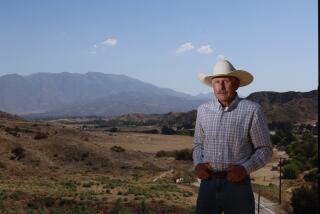Can TwinPorts Plan Ever Get Off Ground? : Transportation: Battle lines are forming over Roberts’ proposal for a binational airport, but the idea has already gathered more momentum than its predecessors.
- Share via
San Diego City Councilman Ron Roberts looks at the barren terrain of Otay Mesa and sees a vision of the future: a gleaming world-class international airport straddling the U.S.-Mexican border that brings millions of visitors and billions of dollars here annually, cementing the two countries’ relations and instantly transforming both San Diego and Tijuana into major players in Pacific Rim trading.
When Councilman Bob Filner looks at the same area, he sees a markedly different view of its place in the 21st Century and flatly makes this prediction: “People will be landing on Mars before they land on (a new airport at) Otay Mesa.”
With those diametrically opposed viewpoints, Roberts and Filner--whose districts include Lindbergh Field and Otay Mesa, respectively--have staked out the end points in the latest round of the long-running debate over San Diego’s airport needs.
That debate, which can be traced back to the propeller-plane era, has generated more than 30 major airport-expansion studies over the past three decades, none of which managed to get off the ground, literally or figuratively.
Roberts, however, hopes to change that with his recent proposal to build a binational airport on Otay Mesa that would share runways and a control tower with Tijuana’s existing airport.
Dubbed “TwinPorts,” Roberts’ proposal calls for a 12,000-foot runway and terminals to be built on the U.S. side of the border, next to Tijuana’s international airport. Linked by a 4,300-foot taxiway connecting the two parallel runways, the dual airports would operate separate arrival and departure terminals, customs checkpoints, immigration, agriculture and other inspection facilities. Planes could land or take off from either runway, and would taxi to the appropriate terminal after landing.
Although formidable obstacles remain--namely, the approval of the U.S. and Mexican governments, identifying funding for the estimated $1.5-billion plus cost, and a host of thorny safety, environmental and logistics questions--Roberts’ plan already has gathered the kind of momentum and support that eluded its predecessors.
Last month, the City Council declared the plan the city’s preferred long-range airport option, and this week it is expected to receive reports on the estimated duration and cost of feasibility studies. The TwinPorts concept also has been endorsed by the Greater San Diego Chamber of Commerce, which, a bit prematurely perhaps, has already labeled the proposed airport “San Diego’s gateway to the future.”
More important, during a meeting with San Diego Mayor Maureen O’Connor and Roberts in Mexico City last month, Mexican President Carlos Salinas de Gortari agreed to set up a binational task force to study the plan.
“We’ve finally moved the debate off the dime,” Roberts said. “There’s a long way to go, but we’ve gotten past the first couple hurdles that stopped all the earlier plans. The challenge now is to build on that progress.”
However, what Roberts characterizes as progress opponents dismiss as little more than a skillfully packaged public-relations campaign built largely on overly optimistic assumptions that minimize the daunting political and practical problems facing the TwinPorts plan. That rosy sales pitch, they charge, stems from a blend of civic overzealousness to find a long-overdue solution to the airport enigma and the political ambition to capitalize on it.
“This is a smoke-and-mirror game with more hype, deception and power-grabbing going on than reality and consensus-building,” argues San Diego County Supervisor Brian Bilbray, an outspoken critic of Roberts’ plan. “It’s a dud that does nothing but institutionalize Lindbergh Field for another 20 years, scaring some people and giving false hope to others.”
Under the TwinPorts proposal, Lindbergh Field would remain open, operating at roughly its existing capacity, primarily as a short-haul and commuter service airport, city officials say. Brown Field, a small, city-owned airport on Otay Mesa, would be closed and its operations shifted to the new border airport, or perhaps to Montgomery Field in Kearny Mesa.
Frustrated by years of civic paralysis on the airport issue, advocates of the TwinPorts plan hail it as the most viable solution to a question that has been a staple of San Diego’s political agenda since the 1960s. Under what Roberts terms a “very optimistic scenario,” the TwinPorts facility could be operational by the turn of the century.
With the physical limitations of Lindbergh’s 475-acre site severely restricting its expansion, city leaders have long recognized the eventual necessity of constructing a second major airport.
The city’s past searches for a replacement, however, were hampered by an inability to select and thoroughly examine a single alternative to Lindbergh, which is nearing capacity both because of its single runway and limited traffic access.
Although some alternately promoted Lindbergh’s expansion or closure, others pushed for joint military-commercial use of Miramar Naval Air Station or for other North County sites. Still others advocated more ambitious, unorthodox ideas ranging from construction of an offshore “floating” airport to a desert “wayport” connected to San Diego and other Southwestern cities by a high-speed monorail.
“There’s an advantage in focusing on one option instead of having our attention scattered all over the place,” O’Connor said. “We’ve never done that before. That may be why we haven’t accomplished much in the past.”
Opponents, however, warn that, if the TwinPorts plan eventually collapses, the years spent exploring it to the exclusion of all other alternatives could simply cause San Diego to lose years of valuable planning time. If the same energy were devoted to studying other options, they argue, a better, less expensive possibility could emerge.
That is particularly true, some contend, in regard to Miramar, which long has been coveted for its central location, its acres of surrounding vacant land--a critical safety factor--and for the simple fact that, as former Escondido Mayor Ernie Cowan puts it, “it’s there.” Runway extensions and the addition of civilian air terminals--not an entirely new airport built from scratch--would be all that is needed, saving time and money.
Navy brass, though, have been unwavering in their insistence that civilian use of Miramar is inconsistent with its military role, citing both security and safety concerns. For that reason, that option has never progressed beyond preliminary talking stages.
Filner and others, however, contend that local officials have been too quick to acquiesce to the Navy’s preference, and they say the Navy’s “no” should not close the door to further discussions.
“Why have we decided it’s going to be easier to negotiate with a foreign country than with our own military?” Filner asks.
Bilbray, meanwhile, angrily charges that city officials and other civic leaders were “pretty darn quick to fold” on the Miramar site, largely because of strong opposition in the politically potent neighborhoods of northern San Diego.
“This is another insulting case of, ‘Let’s dump what we don’t want on the South Bay,’ ” Bilbray said. “The attitude seems to be that it’s easier to shove things like sewage plants, jails and airports on the poor people in the South Bay than on those folks in the north. That way, you take less heat.”
As the decades of inconclusive debate demonstrate, however, any airport proposal engenders considerable “heat”--a pattern likely to be magnified by the fact that TwinPorts has been singled out for closer examination than most of the plans that preceded it.
The current debate begins with questions over TwinPorts’ feasibility--or, more properly, how much time the city should commit to determine whether the plan seems feasible.
Opponents favor a short period of months, supporters describe a one- to two-year period as both more realistic and reasonable. At the outside, Roberts says, the necessary binational agreements should be completed before Salinas leaves office in December, 1994, to prevent a change in administrations from unraveling any earlier negotiations.
Filner’s frustration over a protracted study is exacerbated by what he views as Mexico’s conflicting signals over the TwinPorts plan, despite Salinas’ agreement to form a joint committee to study it.
At last month’s meetings in Mexico City, for example, Mexican Communication and Transportation Minister Andres Caso Lombardo offered a counterproposal: the expansion of Tijuana’s airport to serve both San Diego’s and Tijuana’s needs. A $100-million project already under way will lengthen Tijuana’s existing 9,000-foot runway to 10,500 feet to accommodate jumbo jets, and plans call for an adjacent runway to be built by 1992.
“Mexico won’t even need us, but they can’t come right out and say that,” Filner said. “In international diplomacy, you don’t say ‘no’--you say ‘maybe,’ or, ‘Let’s study it.’ But some people here are so eager to see this work that they read positive signs into everything.”
Complicating those negotiations is the fact that various local and federal agencies will have a hand in reviewing or approving the TwinPorts plan. Besides the City Council, the San Diego Assn. of Governments, as the regional governmental agency, must approve the plan, and county supervisors--who serve as the area’s Air Pollution Control District--also could play a role. On the federal level, the Department of Transportation, Federal Aviation Administration, Customs Service and other agencies likewise will have a voice in any final decision.
With that confusing bureaucratic maze as a backdrop, supporters and opponents have already started skirmishing over questions concerning the noise, safety, environmental and economic impact of the proposed TwinPorts facility.
According to preliminary noise studies, the border airport would produce a 10-square-mile region in which residential development would be incompatible, with a much wider area being subject to occasional noise discomfort from takeoffs and landings.
Combined with the traffic congestion and pollution generated by an airport, Filner argues, that would largely preclude plans for up to 18,000 residential units and industrial development to be built in the area--a claim that Roberts vehemently disputes.
“He’s just misstating and distorting the facts,” Roberts said, noting that the noise study by Orange-based P&D; Technologies concludes that residential development probably could proceed north of Otay Mesa Road. Earlier this month, the council unanimously approved an 849-unit housing project, Robinhood Range, that lies outside the area that would be most affected by airport noise.
Most council members, however, concede that some land-use restrictions are necessary to preserve the city’s options by preventing the kind of interim development in the border region that could pose later obstacles to the airport.
“No one’s denied that there might be some slight impact on housing or industrial development,” Roberts said. “But this isn’t an either-or situation like (Filner) has made it out to be. TwinPorts not only is compatible with those plans, but in fact may push them along quicker than they would have occurred otherwise--if they would have occurred at all.”
Chamber of Commerce spokesman Bob Hudson also points out that the development of quieter aircraft could dramatically diminish the airport’s noise impact by the early 21st Century.
“In 10 years, we may have aircraft that can take off in 500 feet that make no more noise than a skateboard going by,” Hudson said.
Many South Bay residents and political leaders, however, are unwilling to count on technological advances. Complaining that the TwinPorts plan would lead to “a major erosion of our existing quality of life,” Chula Vista Mayor-elect Tim Nader says he intends to organize a group called Citizens Rejecting Airport Siting Hype (CRASH) in an effort to defeat the proposal.
Safety concerns also will help to shape the debate over the proposed border airport. Because of mountains to the east of the proposed site, a parallel alignment of the dual runways would require planes to approach from the east with a 3.4-degree “glide slope”--higher than Lindbergh’s oft-criticized 3.22-degree slope, according to city consultants.
However, by rotating the runway on the U.S. side of the border by 12 degrees, the 3-degree slope that aviation experts consider ideal for instrument landings could be achieved, the consultants stress.
That explanation, however, has left Filner and other skeptics unconvinced.
“A safer airport is the least we should demand, but I’m not sure this plan even gives us that,” Filner said. “Until you know the exact location and size of the airport and the runway alignment, a lot of the noise and safety estimates are just guesswork.”
That is precisely the reason why the proposed TwinPorts feasibility studies should proceed, supporters say.
“This issue is as important to San Diego today as the question of whether the railroad would stop here was in the 1800s,” Roberts said. “After the railroad didn’t stop here, San Diego was a dusty little town for a long, long time. If we don’t do something about the airport soon, I’m afraid we’ll be looking at a very similar situation.”
The TwinPorts Concept
The San Diego City Council has identified a proposed international airport straddling the Otay Mesa-Tijuana border as its preferred method of meeting the region’s long-range airport needs.
Under the so-called “TwinPorts” plan, a 12,000-foot runway would be built on the U.S. side of the border, parallel to the Tijuana airport’s existing runway. Planes could land or take off from either runway and would taxi to the appropriate terminal on either side of the border. Supporters of the plan claim that the dual airport, estimated to cost $1.5 billion to $2 billion, could be built by the turn of the century. The noise contour line on the map encircles the area most affected by takeoffs and landings.
Airport Comparison San Diego Lindbergh: 474 acres Dallas / Ft. Worth International: 17,500 acres Washington Dulles: 10,200 acres Houston Intercontinental: 7,500 acres Chicago O’Hare: 6,600 acres Kansas City: 5,500 acres Denver Stapleton: 5,300 New York Kennedy: 4,600 acres Los Angeles International: 3,500 acres St. Louis Lambert: 2,200 acres Las Vegas: 1,885 acres Source: San Diego Chamber of Commerce
More to Read
Sign up for Essential California
The most important California stories and recommendations in your inbox every morning.
You may occasionally receive promotional content from the Los Angeles Times.













